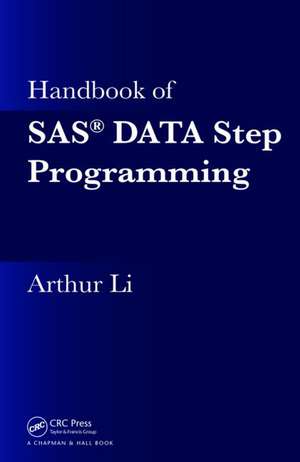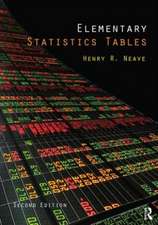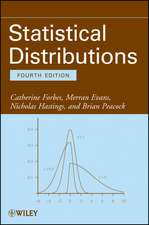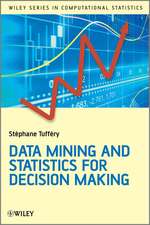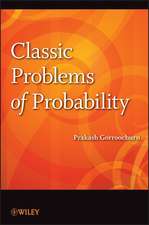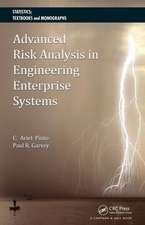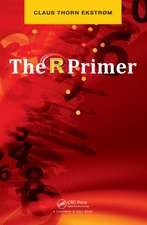Handbook of SAS® DATA Step Programming
Autor Arthur Lien Limba Engleză Hardback – 10 apr 2013
The book helps novices avoid common mistakes resulting from a lack of understanding fundamental and unique SAS programming concepts. It explains that learning syntax does not solve all problems; rather, a thorough comprehension of SAS processing is needed for successful programming. The author also guides readers through a programming task. In most of the examples, the author first presents strategies and steps for solving the problem, then offers a solution, and finally gives a more detailed explanation of the solution.
Understanding the DATA steps, particularly the program data vector (PDV), is critical to proper data manipulation and management in SAS. This book helps SAS programmers thoroughly grasp the concept of DATA step processing and write accurate programs in the DATA step. Numerous supporting materials, including data sets and programs used in the text, are available on the book’s CRC Press web page.
Preț: 1114.70 lei
Preț vechi: 1359.39 lei
-18% Nou
Puncte Express: 1672
Preț estimativ în valută:
213.30€ • 223.26$ • 177.53£
213.30€ • 223.26$ • 177.53£
Carte tipărită la comandă
Livrare economică 31 martie-14 aprilie
Preluare comenzi: 021 569.72.76
Specificații
ISBN-13: 9781466552388
ISBN-10: 1466552387
Pagini: 276
Ilustrații: 28
Dimensiuni: 156 x 234 x 23 mm
Greutate: 0.61 kg
Ediția:New.
Editura: CRC Press
Colecția Chapman and Hall/CRC
ISBN-10: 1466552387
Pagini: 276
Ilustrații: 28
Dimensiuni: 156 x 234 x 23 mm
Greutate: 0.61 kg
Ediția:New.
Editura: CRC Press
Colecția Chapman and Hall/CRC
Cuprins
Introduction to SAS. Creating Variables Conditionally. Understanding How the DATA Step Works. BY-Group Processing in the DATA Step. Writing Loops in the DATA Step. Array Processing. Combining Data Sets. Data Input and Output. Data Step Functions. Useful SAS Procedures. References.
Notă biografică
Arthur Li is a biostatistician at the City of Hope National Medical Center in Los Angeles County, California. He is also a part-time statistical programming instructor at the University of Southern California, where he received an MS in biostatistics. He often gives presentations and seminars on DATA step programming and statistical analysis using SAS software at SAS conferences.
Recenzii
"…covers a good number of topics attractive to SAS users. The strength of the book is a simple and straight-to-the-point approach taken by the author. Examples and a few exercises appearing at the conclusion of each chapter are very helpful in understanding the topics. It is a good source as a supplement to a textbook or a statistics course using SAS. … All of the code is written and explained very efficiently. Anyone interested in the topic will find this handbook very easy to follow."
—The American Statistician, May 2014 "Handbook of SAS DATA Step Programming provides a thorough introduction to the statements and functionalities of the SAS DATA step. The book can be used as an introductory tutorial for beginning SAS programmers or as a reference book for experienced users. … Many users of DATA step have a strong statistical background, but not all of them really try to understand DATA step as a programming language. The Handbook covers this gap and helps statisticians improving their programming efficiency using SAS DATA step."
—Journal of Statistical Software, January 2014
—The American Statistician, May 2014 "Handbook of SAS DATA Step Programming provides a thorough introduction to the statements and functionalities of the SAS DATA step. The book can be used as an introductory tutorial for beginning SAS programmers or as a reference book for experienced users. … Many users of DATA step have a strong statistical background, but not all of them really try to understand DATA step as a programming language. The Handbook covers this gap and helps statisticians improving their programming efficiency using SAS DATA step."
—Journal of Statistical Software, January 2014
Descriere
This handbook shows readers how best to manage and manipulate data by using the DATA step in SAS, helping them avoid common problems when creating SAS data sets. The author explains that learning syntax does not solve all problems; rather, a thorough comprehension of SAS processing is needed for successful programming. He also guides readers through a programming task. In most of the examples, the author first presents strategies and steps for solving the problem, then offers a solution, and finally gives a more detailed explanation of the solution.
